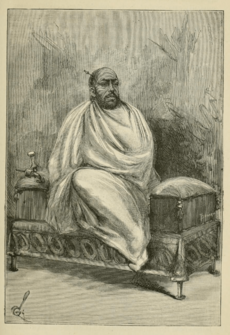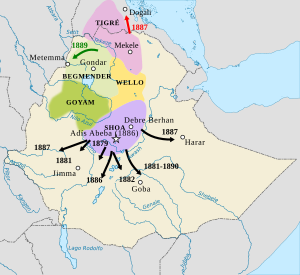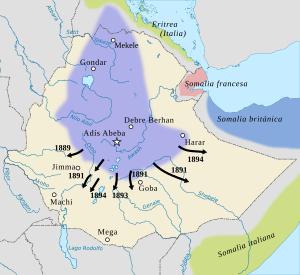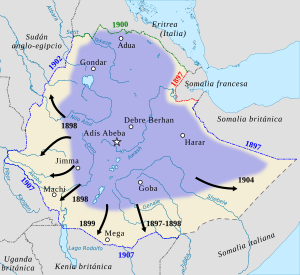Menelik II facts for kids
Quick facts for kids Menelik IIዳግማዊ ምኒልክ |
|||||
|---|---|---|---|---|---|
| Negusa Nagast | |||||
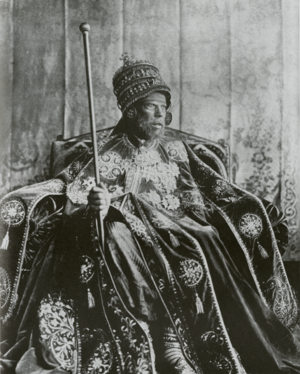 |
|||||
| Emperor of Ethiopia | |||||
| Reign | 10 March 1889 – 12 December 1913 | ||||
| Coronation | 3 November 1889 | ||||
| Predecessor | Yohannes IV | ||||
| Successor | Lij Iyasu (designated but uncrowned Emperor of Ethiopia) | ||||
| Born | 17 August 1844 Angolalla, Shewa, Ethiopian Empire |
||||
| Died | 12 December 1913 (aged 69) Addis Ababa, Ethiopian Empire |
||||
| Burial | Ba'eta Le Mariam Monastery (now Se'el Bet Kidane Meheret Church) Addis Ababa, Ethiopia |
||||
| Spouse | Altash Tewodros (1855–1865) Bafena Wolde Mikael (1865–1882) Taytu Betul (1882–1913) |
||||
| Issue | Zewditu I Shoa Ragad Wossen Seged |
||||
|
|||||
| Dynasty | House of Solomon (Shewan Branch) | ||||
| Father | Haile Melekot (King of Shewa) | ||||
| Mother | Woizero Ejigayehu | ||||
| Religion | Ethiopian Orthodox Tewahedo | ||||
| Styles of Menelik II of Ethiopia |
|
|---|---|
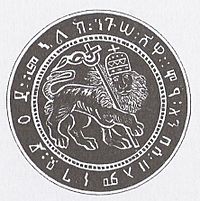 |
|
| Reference style |
|
| Spoken style |
|
| Alternative style |
|
Menelik II (Ge'ez: ዳግማዊ ምኒልክ; born 17 August 1844 – died 12 December 1913) was a powerful leader in Ethiopia. His baptismal name was Sahle Maryam. He first ruled as the King of Shewa from 1866 to 1889. Later, he became the Emperor of Ethiopia in 1889 and ruled until his death in 1913.
During his rule, Menelik II greatly expanded the Ethiopian Empire. He also brought many modern changes to the country. He is famous for leading Ethiopian troops to a major victory against Italian invaders in the First Italo-Ethiopian War. This important win happened at the Battle of Adwa. After this battle, other countries recognized Ethiopia as a truly independent nation. They sent diplomats to his court and helped draw Ethiopia's borders. Menelik also created the first group of government ministers to help manage the empire.
Contents
Early Life and Becoming King
Menelik was born in Angolalla to King Haile Melekot of Shewa. His mother was Ejigayehu Lemma Adyamo. He was given the name Sahle Maryam when he was baptized. He grew up in the royal household and received a traditional church education.
In 1855, Tewodros II, the Emperor of Ethiopia, attacked Shewa. Menelik's father died during these battles. Young Sahle Maryam was captured and taken to the emperor's mountain fort, Amba Magdela. Emperor Tewodros II treated him well and even offered him his daughter, Altash Tewodros, for marriage. Menelik accepted.
Later, Menelik's uncle, Haile Mikael, was made ruler of Shewa. But he rebelled against Emperor Tewodros. Another person, Ato Bezabeh, then took over Shewa and called himself "Negus" (King). The royal family members who were held captive with Menelik did not like this. They helped Menelik escape from Magdala in 1865. He returned to Shewa.
Becoming King of Shewa
When Menelik returned to Shewa, many people supported him. Even Bezabeh's own soldiers joined Menelik. Menelik entered Ankober and declared himself Negus (King) of Shewa.
Menelik was very clever in how he built his power. He held large feasts for people to gain their support. He also made friends with Muslim leaders and formed alliances with the French and Italians. These alliances helped him get firearms and political support against Emperor Yohannes IV. Visitors described Menelik as friendly, smart, and very interested in new weapons. He was also popular with his people and always ready to listen to their problems.
Becoming Emperor of Ethiopia
On 10 March 1889, Emperor Yohannes IV died in a war. Menelik quickly declared himself Emperor on 25 March. Menelik believed he had a stronger claim to the throne because his family line was directly from King Solomon through male ancestors.
Many Ethiopian nobles supported Menelik. On 3 November 1889, Menelik was crowned Emperor Menelik II. This happened at the Church of Mary on Mount Entoto. After his crowning, he traveled through the northern parts of Ethiopia. He received loyalty from local leaders in many regions.
Building Modern Ethiopia and Defeating Invaders
Uniting the Empire
Menelik II is often called the founder of modern Ethiopia. Before his rule, Ethiopia had many wars. Menelik worked to unite the country and stop these conflicts. He brought many northern areas together through agreements. He also expanded his empire to the south and east.
He made alliances with different groups. For example, he appointed Habte Giyorgis Dinagde, who had mixed Gurage-Oromo heritage, as his Minister of Defense. Many areas joined his empire peacefully. In other areas, his army fought to bring them under his rule.
Founding Addis Ababa
For a long time, Ethiopia did not have a fixed capital city. The royal camp moved around. In 1886, Menelik's wife, Empress Taytu Betul, camped at a hot spring. She decided to build a house there. From 1887, this became her permanent home, which she named Addis Ababa (meaning "new flower").
Menelik's generals were given land nearby to build their homes. In 1889, work started on a new royal palace. The city grew very quickly. By 1910, Addis Ababa had about 70,000 permanent residents.
The Great Famine
During Menelik's reign, a terrible famine happened from 1888 to 1892. This was the worst famine in the region's history. It killed about one-third of the population. The famine was caused by a cattle disease called rinderpest. This disease wiped out over 90% of the cattle.
The Wuchale Treaty and War with Italy
On 2 May 1889, Menelik signed a treaty with Italy at Wuchale. This treaty was meant to define the border between Ethiopia and the Italian colony of Eritrea. However, there were two versions of the treaty: one in Italian and one in Amharic (Ethiopian language).
The Italian version said that Ethiopia had to use Italy for all its foreign affairs. This would have made Ethiopia a protectorate of Italy, meaning Italy would control Ethiopia's international relations. Menelik had not agreed to this. When he found out about the difference, he rejected the treaty. The Italians tried to bribe him, but he refused.
Italy then prepared to invade Ethiopia. On 17 September 1895, Menelik ordered all Ethiopian nobles to gather their armies. He told them that an enemy had come to destroy their homeland and faith. He said he would defend Ethiopia with God's help.
The Italian general, Oreste Baratieri, thought Menelik's army was small. But the Ethiopians were well-armed with modern French rifles and artillery. Menelik made sure his soldiers were trained to use these weapons.
On 7 December 1895, Menelik's army attacked an Italian force at Boota Hill. The Ethiopians won this battle. Later, Menelik's general, Ras Makonnen, defeated another Italian force and forced them to retreat.
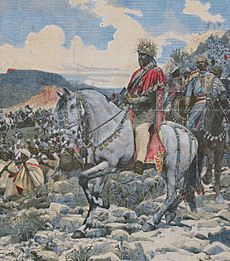
On 19 January 1896, the Italians at Fort Mekele surrendered to Ras Makonnen. Menelik allowed the Italian soldiers to leave freely. He said his fight was with the Italian government, not the soldiers. This act of kindness helped show the world that the Italian claims of Ethiopian cruelty were false.
Finally, on 1 March 1896, the two armies met at Adwa. The Ethiopians won a decisive victory. This battle was a huge defeat for Italy. It showed that an African nation could defeat a European colonial power.
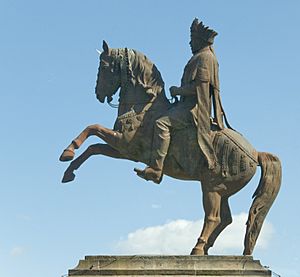
After the victory at Adwa, Menelik could have taken over Eritrea. But he chose to make peace instead. He signed the Treaty of Addis Ababa with Italy. This treaty forced Italy to recognize Ethiopia's full independence.
Ethiopian Army at Adwa
The Ethiopian army at the Battle of Adwa was made up of fighters from all over the country. Different ethnic groups and tribes came together for a common national cause. They fought side-by-side, helping each other during the battle. This unity was a key reason for their victory.
Modern Changes During Menelik's Rule
Connecting with Other Countries
Menelik wanted to expand Ethiopia's connections with other countries. He looked to Europe and found Imperial Russia willing to form a relationship. From 1893 to 1913, the Russian government sent many advisers and volunteers to Ethiopia. Russian support also led to the first hospital in Ethiopia, set up by a Russian Red Cross mission after the Battle of Adwa.
Ending Slave Trading
By the mid-1890s, Menelik actively worked to stop the slave trade. He ordered the destruction of slave markets and punished slave traders. While earlier emperors had also tried to outlaw slave trading, Menelik made strong efforts to enforce this rule.
Bringing New Technology
Menelik II was very interested in modern technology. He wanted to bring Western advances to Ethiopia. After his victory at Adwa, many Westerners came to Ethiopia for trade and other opportunities.
Menelik II started the first modern bank in Ethiopia, called the Bank of Abyssinia. He also introduced the first modern postal system. He began work on the Addis Ababa –Djibouti railway with the French. He brought electricity, the telephone, the telegraph, motor cars, and modern plumbing to Addis Ababa. He even tried to introduce new coins.
In 1894, Menelik allowed a railway to be built from the French port of Djibouti to his capital. However, he stopped the railway's extension for four years when France claimed control over the line in Ethiopian territory. In 1906, when France, the United Kingdom, and Italy agreed on joint control, Menelik confirmed his full rights over his empire.
Personal Life and Death
Menelik could speak French, English, and Italian. He enjoyed reading and was interested in finance, investing in various businesses.
Wives of Menelik II
Menelik married three times. His third wife was Taytu Betul, whom he married in 1883. This marriage was a full church service, meaning it was considered permanent. Taytu Betul became Empress and had a lot of influence in Menelik's court. She was from a powerful noble family. She even went to the Battle of Adwa with her own troops. Towards the end of Menelik's life, when he was ill, Taytu Betul largely managed the empire.
Children of Menelik II
Menelik had some children before his marriage to Taytu Betul. He recognized three of them as his own:
- A daughter, Woizero Shoaregga Menelik, born in 1867. She had a son, Abeto Wossen Seged Wodajo, who was not considered for the throne due to dwarfism. She also had a son named Lij Iyasu, who later became the next ruler after Menelik.
- A daughter, Woizero (later Empress) Zewditu Menelik, born in 1876. She married four times but did not have children who survived to adulthood. She became Empress in 1916.
- A son, Abeto Asfa Wossen Menelik, born in 1873. He died young without marrying or having children.
Menelik's only recognized son, Abeto Asfa Wossen Menelik, died young. His elder daughter, Shoaregga, had a son, Lij Iyasu, who was meant to be the next Emperor. However, Iyasu was never crowned and was later removed from power by nobles in 1916.
Menelik's younger daughter, Zewditu Menelik, became Empress in 1916. She was the first woman to hold this position in Ethiopia since the Queen of Sheba. She had ceremonial duties, but the real power was held by her cousin, Ras Tafari Makonnen, who later became Emperor Haile Selassie.
Illness and Death
On 27 October 1909, Menelik II suffered a severe stroke. After this, he could no longer rule. Empress Taytu took over as the main ruler for a time. Later, a council of regency was formed to govern the country.
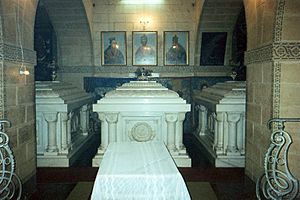
Emperor Menelik II died on 12 December 1913. He was first buried quickly without a public ceremony. In 1916, his body was moved and reburied in a special church at Ba'eta Le Mariam Monastery in Addis Ababa.
After Menelik's death, the council of regency continued to rule. Lij Iyasu was never crowned Emperor. Empress Zewditu I officially became the next ruler on 27 September 1916.
Legacy of Menelik II
Menelik II is widely seen as the founder of modern Ethiopia. The Adwa Victory Day is celebrated every March in Ethiopia. This victory also inspired Pan-African movements around the world, showing that African nations could stand strong against colonial powers.
Menelik II is featured as a leader in the video game Civilization VI. His special ability in the game helps cities built on hills and units fighting in hills.
Notable Quotes
- “Ethiopia has been for fourteen centuries a Christian island in a sea of pagans.” - Menelik Letter to European powers
- “This country is mine and no other nation can have it.” - Menelik's response to Italian claims over Ethiopia
- “When united, the victory is ours as many small pieces of bark can conquer an elephant.” - Menelik using a traditional saying
- “There was never a time when united that Ethiopians lost to an enemy in history.” - speaking to war messengers
See also
 In Spanish: Menelik II para niños
In Spanish: Menelik II para niños


